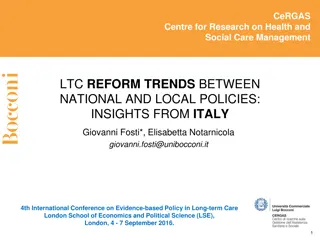Local Government Structure in Italy: A Comprehensive Overview
The system of multilevel government in Italy is composed of regions, provinces, and communes, forming a regional state with 107 provinces and 7,904 municipalities. The governance structure includes direct elections for regional councils, executive committees, presidents, and mayors at different levels. Additionally, the election system has evolved since the 1990s to include strong mayor forms for municipalities based on population size, with variations in voting systems and party connections. The local party system in Italy is dominated by strong political parties, excluding the 5 Stars Movement.
Download Presentation

Please find below an Image/Link to download the presentation.
The content on the website is provided AS IS for your information and personal use only. It may not be sold, licensed, or shared on other websites without obtaining consent from the author. Download presentation by click this link. If you encounter any issues during the download, it is possible that the publisher has removed the file from their server.
E N D
Presentation Transcript
Local government in Italy
System of multilevel government in Italy 1/2 regions (regioni), provinces (province), and communes (comuni) 15 ordinary regions x 5 regions with special status => Italy as a regional state 107 provinces incl. 14 metropolitan cities 7904 municipalities
System of multilevel government in Italy 2/2 regions council, executive committee and president (mostly direct elections) provinces - president (elected by the mayors and councillors of the municipalities) or metropolitan mayor municipalities council, municipal board and mayor (direct elections)
Executive model + election system since the 90 s direct elections + executive boards appointed by the mayor/president (governor) => strong mayor (governor) form municipalities up to 15 000 inhabitans simple majority system, connected lists, 2/3 of the seats for the list of the mayor municipalities with more then 15 000 inhabitans two round syst m, possibility to vote for mayor+his party, mayor+different party, just mayor, 60% of the seats for the party of the mayor (if different party did not receive more then 50% of the seats), changes in the connections between first and second round
Party system at the local level strong political parties except of the 5 Stars Movement























